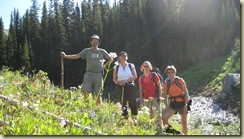Jack Layton Walked the Talk in Cranbrook
by Gerry Warner
Cranbrook Daily Townsman
After several days of saturation coverage, I admit the media outpouring over the untimely passing of Jack Layton gets to be a bit much even for an admirer like myself. But please permit me to add one more anecdote that illustrates the character of the former NDP leader and that incident took place right here in Cranbrook.
It happened in May during the spring election campaign when Layton was in town to give a boost to local NDP candidate Mark Shmigelsky. An informal news conference took place at Hot Shots, the popular java hangout on Victoria Street and a somewhat wan, even then, Layton was regaling the crowd with why they should support Shmigelsky and vote NDP.
Another reporter was covering the meeting and I was just there on the fringes of the crowd just out of interest and because I'd never met Layton before. And he was largely as I expected glib, congenial and articulate – the kind of guy you wouldn't mind bringing home for supper or having a beer with.
Comments and questions were flying back and forth when I suddenly saw a well-known Cranbrookian pull up to the window for his morning cup of Joe. I'd written about this character before because he pioneered a rather unique form of transportation in town. It was Bazil Dodgson, in his brand, new, red “Bazmobile,” a battery operated scooter that he bought at the local Medichair outlet that virtually gave him a new lease on life after he could no longer drive a regular gas guzzler.
So at this point, I called out, “Jack, Jack,” and rather rudely interrupted the conversation around the table. “You've got to see this. It's the future.” When Stephen Harper was here a few weeks later, I never would have dreamed of interrupting him like that, but something about Layton's easy-going, laid-back style removed the fear and indeed he turned and looked at the Bazmobile through the window and started asking questions about it despite my rudeness.
I felt relieved and, indeed, I took the chance because I was aware of Layton's politicking on behalf of bike trails early in his career when he was a councilor in Toronto. But that's not all because what really surprised me took place about a half-hour later. I was driving out of the Hot Shots parking lot when what do I see – Jack Layton by himself in the parking lot taking pictures of the Bazmobile. I can't remember if he had his cane with him or not, but I couldn't help thinking to myself that he really must take issues like transportation mobility seriously, especially when it came to seniors.
And now he's gone. Far too soon gone and most Canadians, regardless of what their politics are, would gladly acknowledge the country has lost a great man – and rarer still – a great man in politics. I think Prime Minister Harper recognized this when he graciously agreed to Layton having a state funeral, something usually reserved for dead prime ministers, governor generals, statesmen and the like.
Great is a word I don't normally throw around and I'm hesitant to apply it even to Jack Layton. But I have to admit his dying letter to Canadians had an eloquence that truly deserved to be called great, especially the last paragraph which is worth repeating:
“My friends, love is better than anger. Hope is better than fear. Optimism is better than despair. So let us be loving, hopeful and optimistic. And we'll change the world.”
That is one of the most evocative cri de coeurs I have ever heard in my life, a veritable mantra for building a better world and I don't care who said it because it transcends the often shabby world of politics and is an inspiration for all.
And that's why I think Jack Layton deserves the appellation “great.” He made us all a bit better and without him we're all just going to have to try a little harder.
– 30 –




